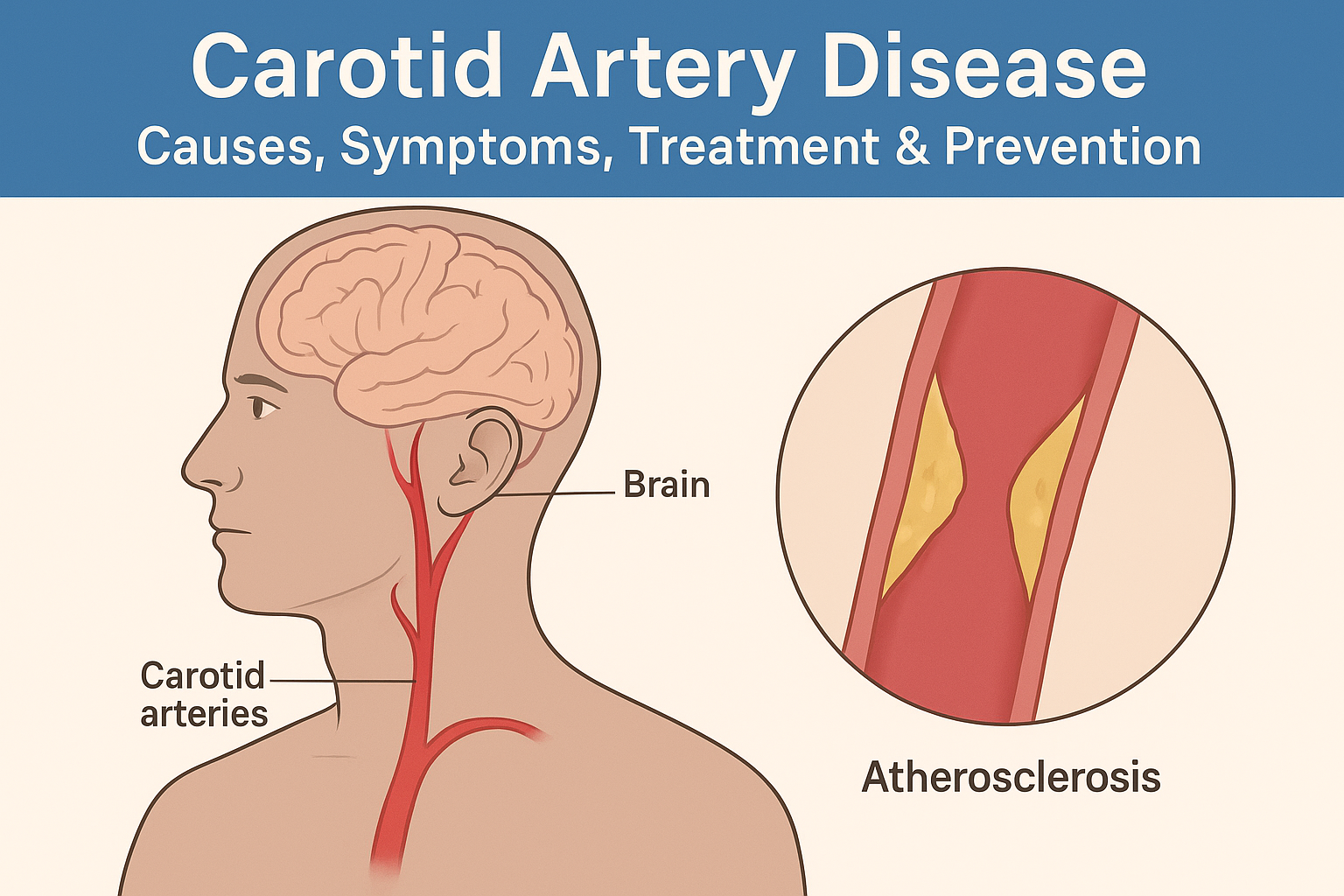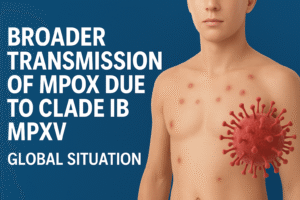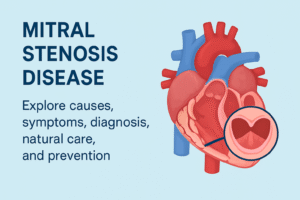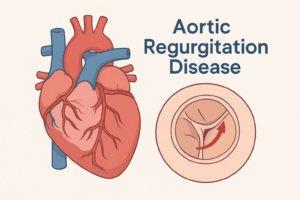Carotid artery disease is one of those silent yet dangerous health conditions that often develops unnoticed—until it leads to serious complications such as stroke. Millions of people worldwide are affected, but the good news is that early detection, lifestyle changes, and preventive care can significantly reduce the risks.
Have you ever wondered how a seemingly small thing, like what you eat every day or whether you smoke, could silently decide the future of your brain’s health? That’s exactly the story with carotid artery disease. Most people don’t even realize they have it—until the body sends a wake-up call in the form of a mini-stroke (TIA) or, worse, a major stroke.
In this guide, we’ll break down everything you need to know about carotid artery disease—its causes, stages, symptoms, risk factors, prevention strategies, treatments without medicine, and even its global impact—so you can stay informed and proactive about your health.
What is Carotid Artery Disease?
Carotid artery disease occurs when the two major arteries in your neck—the carotid arteries—become narrowed or blocked. These arteries are like highways that carry oxygen-rich blood to the brain. Any traffic jam (blockage) on these routes can have severe consequences because the brain is extremely sensitive to interruptions in blood supply.
The narrowing usually happens because of atherosclerosis, a condition where fatty deposits (plaque) build up inside the artery walls. Think of it like dirt collecting in a water pipe—the more it builds up, the harder it is for water (or in this case, blood) to pass through. Over time, this reduces blood flow and increases the risk of stroke.
Causes of Carotid Artery Disease
Carotid artery disease doesn’t happen overnight—it’s a slow, progressive condition. The main culprit is plaque buildup, and the reasons behind it are often linked to lifestyle and health factors:
- High cholesterol levels – Excess cholesterol contributes to fatty deposits in the arteries.
- High blood pressure – Continuous pressure weakens artery walls, allowing plaque to stick more easily.
- Smoking – Tobacco not only damages blood vessels but also accelerates plaque buildup.
- Diabetes – High blood sugar harms arteries and speeds up atherosclerosis.
- Obesity – Extra weight stresses the cardiovascular system.
- Unhealthy diet – High intake of fried foods, processed snacks, trans fats, and added sugars increases risk.
Genetics also play a role. If heart disease, stroke, or high cholesterol runs in your family, you may be more vulnerable.
Stages of Carotid Artery Disease
Like most chronic conditions, carotid artery disease progresses gradually:
- Early stage (mild narrowing) – Plaque starts building up but symptoms are usually absent.
- Moderate stage – Blood flow decreases slightly; risk of clots increases though symptoms may still be silent.
- Severe stage (critical narrowing) – Significant blockage raises the chance of a major stroke.
- Complete blockage – The artery becomes fully obstructed, often leading to a severe or life-threatening stroke.
Because the early stages rarely show symptoms, screenings are critical—especially if you’re at high risk.
Types of Carotid Artery Disease
Doctors usually classify carotid artery disease based on severity:
- Asymptomatic carotid stenosis – Narrowing is present but no symptoms yet.
- Symptomatic carotid stenosis – Patients experience warning signs such as transient ischemic attacks (TIAs) or minor strokes.
- Complete occlusion – The artery is fully blocked and requires urgent medical intervention.
Symptoms: The Silent Killer’s Warning Signs
Carotid artery disease is often called a “silent killer” because most people don’t realize they have it until it becomes dangerous. But there are red flags—usually in the form of TIAs (mini-strokes):
- Sudden weakness or numbness on one side of the body
- Trouble speaking or slurred speech
- Sudden vision problems in one or both eyes
- Dizziness or loss of balance
- Severe, unexplained headache
A TIA is like your body’s alarm system. It means blood flow to the brain is temporarily reduced. If ignored, a full-blown stroke could be next. If you experience any of these signs, seek emergency medical help immediately.
Treatments Without Medicine
While doctors may prescribe medications (like statins or blood thinners) or recommend surgery in severe cases, many lifestyle-focused strategies can help manage or slow down carotid artery disease. These include:
1. Healthy Diet
Adopt a heart-friendly diet, such as the Mediterranean diet, filled with fruits, vegetables, whole grains, fish, lean protein, and healthy fats. Cut down on processed foods, fried snacks, trans fats, and excess salt.
2. Regular Exercise
Aim for 30 minutes of moderate activity (brisk walking, cycling, swimming, or yoga) at least five times a week. Exercise not only improves circulation but also lowers cholesterol and blood pressure.
3. Quit Smoking
Quitting smoking is perhaps the most powerful step you can take. Within months of quitting, your arteries start repairing themselves.
4. Weight Management
Maintaining a healthy weight reduces strain on your heart and arteries. Even a 5–10% weight loss can make a big difference.
5. Stress Management
Chronic stress damages arteries. Practices like yoga, meditation, mindfulness, or simple deep breathing can lower stress and improve heart health.
6. Natural Supplements (with medical advice)
Omega-3 fatty acids, garlic, and green tea extract may support vascular health. But always consult your doctor before adding supplements.
Prevention is Better Than Cure
Carotid artery disease is preventable to a large extent. Some simple, consistent choices can dramatically lower your risk:
- Eat a nutrient-rich, balanced diet
- Stay active and avoid long sitting hours
- Avoid smoking and excessive alcohol
- Get regular health checkups (cholesterol, blood pressure, sugar)
- Sleep well and maintain a healthy routine
- Manage chronic conditions like diabetes or hypertension carefully
Risk Factors You Can’t Ignore
Some people are more prone to carotid artery disease due to:
Global Impact of Carotid Artery Disease
Carotid artery disease isn’t just an individual health issue—it’s a global concern.
- Stroke burden – WHO ranks stroke as the second leading cause of death worldwide, and carotid disease is a key contributor.
- Economic cost – Billions are spent annually on stroke treatment, rehabilitation, and lost productivity.
- Aging population – With rising life expectancy, cases are increasing, especially in developing countries.
- Healthcare disparity – Access to preventive screenings like carotid ultrasound is limited in low-income regions, leading to higher stroke rates.
By prioritizing public health awareness, screenings, and lifestyle education, countries can significantly reduce stroke-related deaths.
Final Thoughts
Carotid artery disease may sound intimidating, but the truth is you have a lot more control over it than you think. The daily choices you make what you eat, how often you move, how well you sleep, whether you smoke play a powerful role in protecting your arteries and your brain.
If you or someone you love falls into the high-risk category, don’t wait for symptoms to show up. Schedule routine checkups, take lifestyle changes seriously, and remember: prevention is the best cure.
Your brain is your most valuable asset protecting its blood supply is protecting your future.






